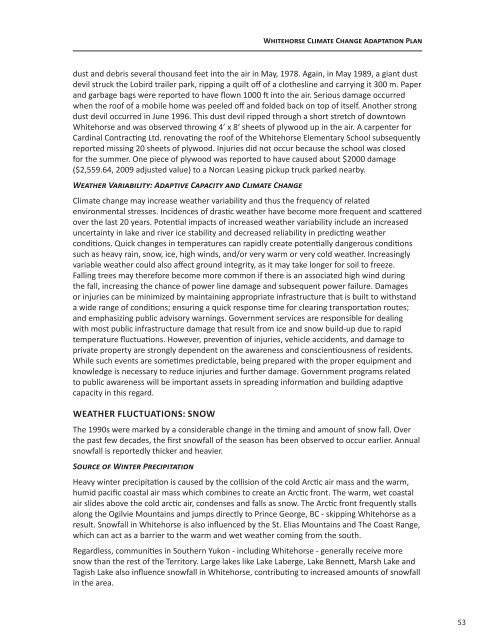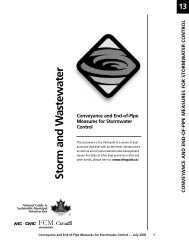Whitehorse Climate Change Adaptation Plan - Yukon College
Whitehorse Climate Change Adaptation Plan - Yukon College
Whitehorse Climate Change Adaptation Plan - Yukon College
Create successful ePaper yourself
Turn your PDF publications into a flip-book with our unique Google optimized e-Paper software.
dust and debris several thousand feet into the air in May, 1978. Again, in May 1989, a giant dust<br />
devil struck the Lobird trailer park, ripping a quilt off of a clothesline and carrying it 300 m. Paper<br />
and garbage bags were reported to have flown 1000 ft into the air. Serious damage occurred<br />
when the roof of a mobile home was peeled off and folded back on top of itself. Another strong<br />
dust devil occurred in June 1996. This dust devil ripped through a short stretch of downtown<br />
<strong>Whitehorse</strong> and was observed throwing 4’ x 8‘ sheets of plywood up in the air. A carpenter for<br />
Cardinal Contracting Ltd. renovating the roof of the <strong>Whitehorse</strong> Elementary School subsequently<br />
reported missing 20 sheets of plywood. Injuries did not occur because the school was closed<br />
for the summer. One piece of plywood was reported to have caused about $2000 damage<br />
($2,559.64, 2009 adjusted value) to a Norcan Leasing pickup truck parked nearby.<br />
Weather Variability: Adaptive Capacity and <strong>Climate</strong> <strong>Change</strong><br />
<strong>Climate</strong> change may increase weather variability and thus the frequency of related<br />
environmental stresses. Incidences of drastic weather have become more frequent and scattered<br />
over the last 20 years. Potential impacts of increased weather variability include an increased<br />
uncertainty in lake and river ice stability and decreased reliability in predicting weather<br />
conditions. Quick changes in temperatures can rapidly create potentially dangerous conditions<br />
such as heavy rain, snow, ice, high winds, and/or very warm or very cold weather. Increasingly<br />
variable weather could also affect ground integrity, as it may take longer for soil to freeze.<br />
Falling trees may therefore become more common if there is an associated high wind during<br />
the fall, increasing the chance of power line damage and subsequent power failure. Damages<br />
or injuries can be minimized by maintaining appropriate infrastructure that is built to withstand<br />
a wide range of conditions; ensuring a quick response time for clearing transportation routes;<br />
and emphasizing public advisory warnings. Government services are responsible for dealing<br />
with most public infrastructure damage that result from ice and snow build-up due to rapid<br />
temperature fluctuations. However, prevention of injuries, vehicle accidents, and damage to<br />
private property are strongly dependent on the awareness and conscientiousness of residents.<br />
While such events are sometimes predictable, being prepared with the proper equipment and<br />
knowledge is necessary to reduce injuries and further damage. Government programs related<br />
to public awareness will be important assets in spreading information and building adaptive<br />
capacity in this regard.<br />
WEATHER FLUCTUATIONS: SNOW<br />
<strong>Whitehorse</strong> <strong>Climate</strong> <strong>Change</strong> <strong>Adaptation</strong> <strong>Plan</strong><br />
The 1990s were marked by a considerable change in the timing and amount of snow fall. Over<br />
the past few decades, the first snowfall of the season has been observed to occur earlier. Annual<br />
snowfall is reportedly thicker and heavier.<br />
Source of Winter Precipitation<br />
Heavy winter precipitation is caused by the collision of the cold Arctic air mass and the warm,<br />
humid pacific coastal air mass which combines to create an Arctic front. The warm, wet coastal<br />
air slides above the cold arctic air, condenses and falls as snow. The Arctic front frequently stalls<br />
along the Ogilvie Mountains and jumps directly to Prince George, BC - skipping <strong>Whitehorse</strong> as a<br />
result. Snowfall in <strong>Whitehorse</strong> is also influenced by the St. Elias Mountains and The Coast Range,<br />
which can act as a barrier to the warm and wet weather coming from the south.<br />
Regardless, communities in Southern <strong>Yukon</strong> - including <strong>Whitehorse</strong> - generally receive more<br />
snow than the rest of the Territory. Large lakes like Lake Laberge, Lake Bennett, Marsh Lake and<br />
Tagish Lake also influence snowfall in <strong>Whitehorse</strong>, contributing to increased amounts of snowfall<br />
in the area.<br />
53

















